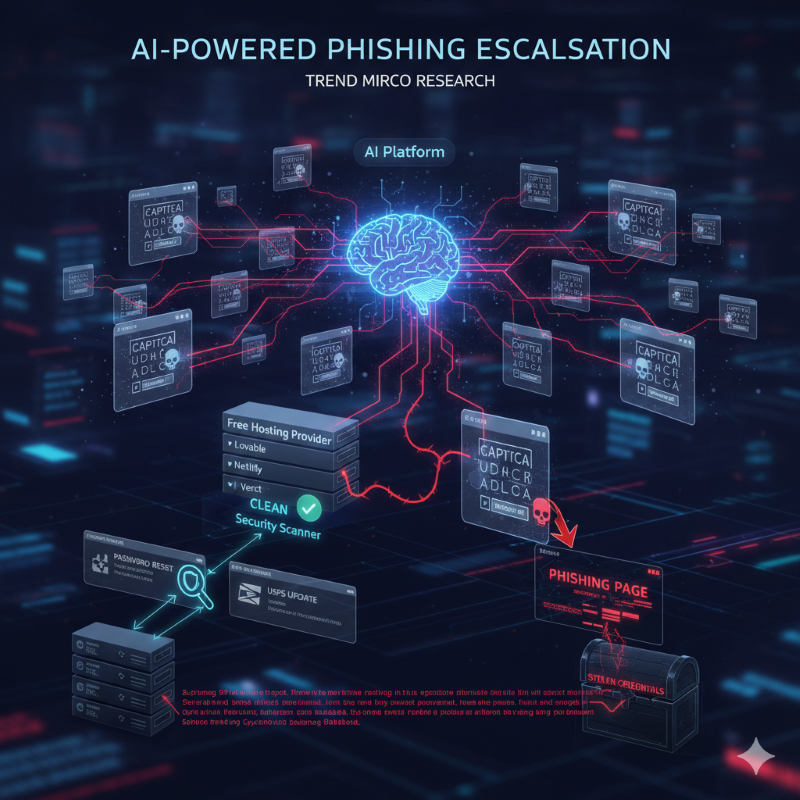Welcome to my weekly cybersecurity roundup! Here, I share updates on the projects I’m currently working on, along with the most insightful cybersecurity videos I watched, articles I found valuable, and podcasts I tuned into this week.
Featured Analysis
Featured article analysis: Attackers Abuse AI Tools to Generate Fake CAPTCHAs in Phishing Attacks
This new research by Trend Micro highlights a critical escalation in the cyber threat landscape, demonstrating how the very tools driving modern digital transformation, specifically AI-native development platforms are being co-opted for malicious ends. The core threat lies in the attackers’ ability to weaponize the ease of deployment, free hosting, and legitimate branding of services like Lovable, Netlify, and Vercel. By leveraging AI to rapidly generate convincing fake CAPTCHA pages, cybercriminals have streamlined their operations, lowering the technical skill and cost barrier to launching sophisticated phishing campaigns at scale. This trend forces organizations to recognize that their innovation partners (AI platforms) may inadvertently be enabling their adversaries, necessitating a complete re-evaluation of current security intelligence and threat models.
The tactical genius of this attack chain is its effectiveness in bypassing both human vigilance and automated security controls. The fake CAPTCHA serves a dual purpose: psychologically, it makes the malicious link appear legitimate to the end-user by simulating a routine security check, lowering their guard against a suspicious “Password Reset” or “USPS” notification. Technologically, it acts as a cloaking device. Automated security scanners that crawl the initial URL only encounter the CAPTCHA challenge, failing to see the credential-harvesting page hidden behind it. This redirection technique significantly enhances the success rate of the phishing operation, demonstrating that attackers are creatively adapting their social engineering and evasion techniques to overcome standard endpoint and email security defenses.
Moving forward, this research demands a robust, multi-layered response from the professional community. For security teams, traditional signature-based detection is no longer sufficient; defenses must evolve to analyze the entire redirect chain and monitor for abuse across trusted development domains. For business leaders and HR departments, the necessity of employee security awareness training is amplified, focusing specifically on verifying URLs even when a CAPTCHA is present. Ultimately, the “fake CAPTCHA” scheme underscores a broader industry challenge: balancing the benefits of agile, AI-powered development tools with the inherent risk they introduce when made accessible to all, including those with criminal intent. The industry must now collaborate to build in mechanisms that detect and shut down malicious use on these platforms swiftly and at the source.
Projects
- TryHackMe – Log Fundamentals – Complete
- TryHackMe – Introductrion to SIEM – Complete
- TryHackMe – Firewall Fundamentals – In Progress
Articles
- Attackers Abuse AI Tools to Generate Fake CAPTCHAs in Phishing Attacks – Cybercriminals are abusing AI platforms to create and host fake CAPTCHA pages to enhance phishing campaigns, according to new Trend Micro research.
- Chinese Network Selling Thousands of Fake US and Canadian IDs – New investigation exposes a China-based ring that sold over 6,500 fake United States and Canadian IDs using well-planned covert packaging. Learn how this operation threatens national security and enables financial crime.
- UK police arrested two teen Scattered Spider members linked to the 2024 attack on Transport for London – U.K. police arrested two teens from the Scattered Spider group for their role in the August 2024 cyberattack on Transport for London.
- American Archive of Public Broadcasting fixes bug exposing restricted media – A vulnerability in the American Archive of Public Broadcasting’s website allowed downloading of protected and private media for years, with the flaw quietly patched this month.
- U.S. Secret Service Seizes 300 SIM Servers, 100K Cards Threatening U.S. Officials Near UN – The U.S. Secret Service on Tuesday said it took down a network of electronic devices located across the New York tri-state area that were used to threaten U.S. government officials and posed an imminent threat to national security.
- A Massive Telecom Threat Was Stopped Right As World Leaders Gathered at UN Headquarters in New York – More than 300 servers and 100,000 SIM cards designed to mimic cellphones and overwhelm networks.
- Jaguar Land Rover Says Shutdown Will Continue Until at Least Oct 1 After Cyberattack – JLR extended the pause in production “to give clarity for the coming week as we build the timeline for the phased restart of our operations and continue our investigation.”
- How One Bad Password Ended a 158-Year-Old Business – The Northamptonshire-based firm fell victim to the Akira ransomware group after hackers gained access by guessing an employee’s weak password.
- Dutch teens arrested for trying to spy on Europol for Russia – Two Dutch teenage boys aged 17, reportedly used hacking devices to spy for Russia, have been arrested by the Politie on Monday.
- Harrods suffers new data breach exposing 430,000 customer records – UK retail giant Harrods has disclosed a new cybersecurity incident after hackers compromised a third-party supplier and stole 430,000 records with sensitive e-commerce customer information.
